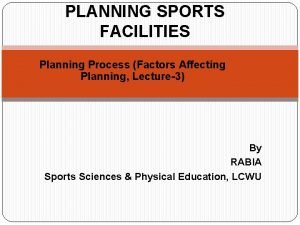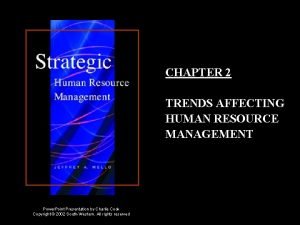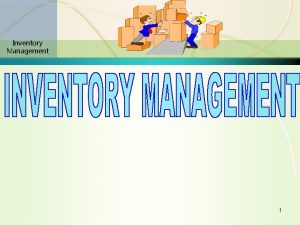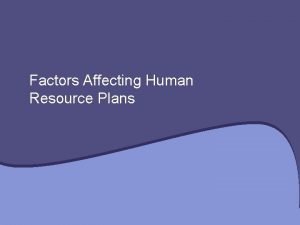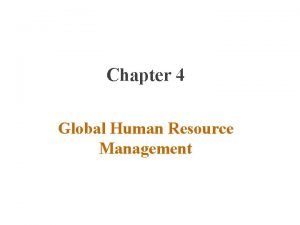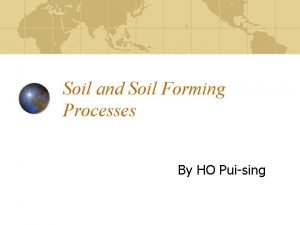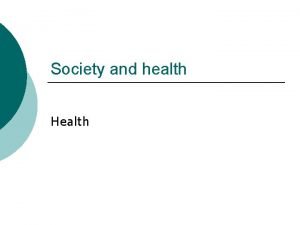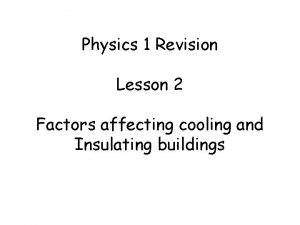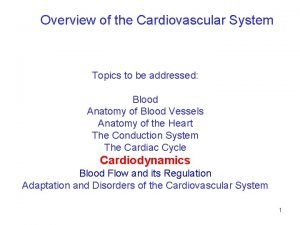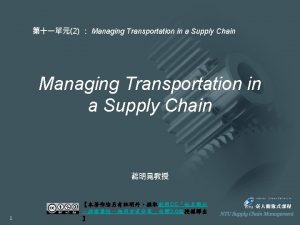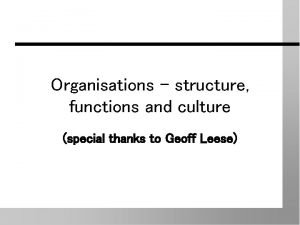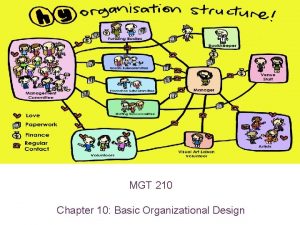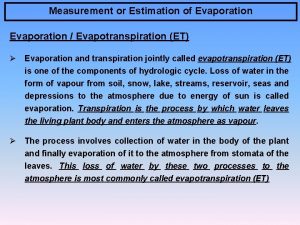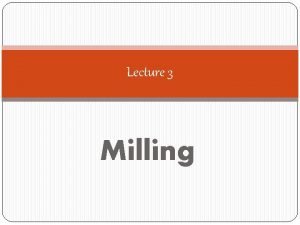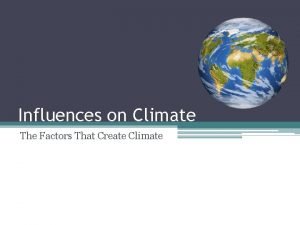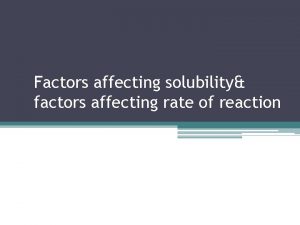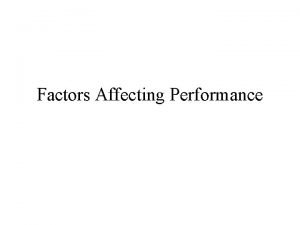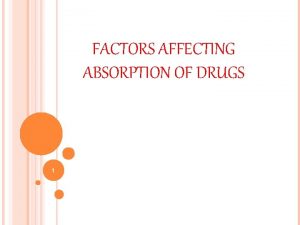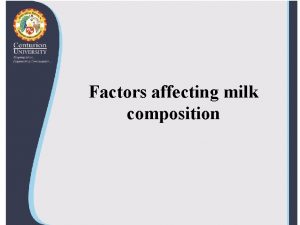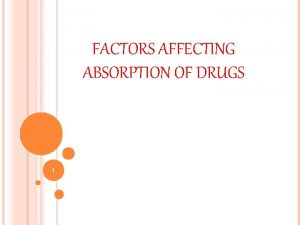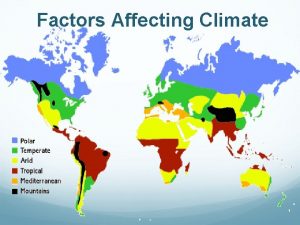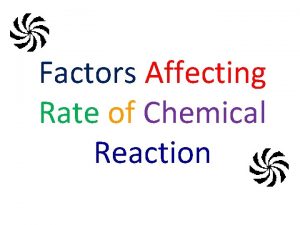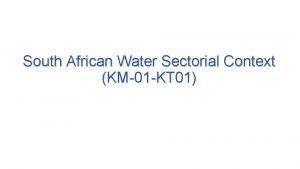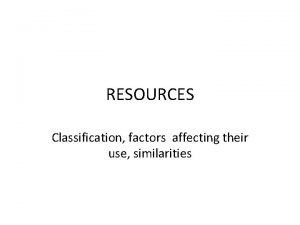Factors Affecting Water Resources Management KM01 KT 04




































- Slides: 36

Factors Affecting Water Resources Management (KM-01 -KT 04)

Outline • Objective of long-term sustainability • Balancing the protection of the ecological environment with the need for water availability for social and economic development • Broad level perspective of the interrelationship between the various water resource elements such as the water user sectors, Resource Directed Measures (RDM), Source Directed Measures (SDM), the Reserve, water quality aspects, ecological aspects, economic and financial considerations for sustainable water resources management, Infrastructure, decision support tools and modelling techniques

Objective of long-term sustainability • Sustainable Development is an old concept that has been used in the management of renewable natural resources to ensure that the rate of harvesting a resource is smaller than the rate of its renewal. • "humanity has the ability to make development sustainable—to ensure that it meets the needs of the present without compromising the ability of future generations to meet their own needs". • This aim should be achieved while minimizing the losses (maximizing the gains) to economic, social and environmental systems. • The availability of water in adequate quantity and quality is a necessary condition for sustainable development. • Water, the basic element of the life support system of the planet, is indispensable to sustain any form of life and virtually every human activity.

• An adequate and reliable supply of water of proper quality for the entire population of the Globe and for preserving the hydrological, biological and chemical functions of ecosystems is still a remote goal. • The increased demand already cannot be met in a number of locations and at all times at present under the natural variabilities of temperature and precipitation. • Water shortage is therefore likely to be the most dominant water problem in the forthcoming century, jeopardizing sustainable development. • Yet, at the end of the Decade, despite all the unquestionable achievements, a large number of human beings (of the order of one billion) still lacked clean and safe water, largely because population growth has outweighed all the progress achieved in water supply. • The number of people without safe water supply has been growing up to present.

• The need of constraining human activities within the carrying capacity of the Earth system has been ubiquitously and unanimously accepted. • Agenda 21 (UNCED, 1993) bearing the subtitle "Programme of Action for Sustainable Development", which serves as "a comprehensive blueprint for action to be taken globally", paves the way forward. • Worldwide acceptance of integrated water resource management is a recent imperative. The notion is based on the perception of water as an integral part of the ecosystem, a natural resource and a social and economic good. • It embraces quantity and quality aspects, surface water and groundwater, and multi-interest competing demands. • It should enhance the efficiency of water use, sustainable water utilization patterns, water conservation, and wastage minimization

Balancing the protection of the ecological environment with the need for water availability for social and economic development • In Agenda 21 (UNCED, 1993), the blueprint for sustainable development, a concern was expressed that commonly used indicators do not provide adequate measures of sustainability. • The United Nations Commission on Sustainable Development established a multi-year thematic programme on indicators. • One of candidate indicators being proposed by WMO is the density of hydrological networks defined as the average area served by one hydrological station (Kundzewicz, 1996). • Knowledge and understanding of freshwater resources is essential for sustainable development. • Therefore, hydrological observations should be recognized as an essential component of sustainable water resources development.

• Hydrological information on water levels, discharge, sediment and water quality is necessary for a number of projects, whereas in a particular application information on time series maxima or minima of a variable may be needed (WMO, 1994). • Examples of such projects for which hydrological information is indispensable comprise water engineering works (dams, reservoirs, spillways, canals, diversions, hydropower, etc. ) as well as those in the area of water quality, zoning, insurance, standards and legislation. • Before launching a freshwater-related project, or considering forecasts and response strategies, it is essential to know how much water and of what quality has been available in the past-to-present. • The basic hydrological network should therefore provide a level of hydrological information that would preclude gross mistakes in decision making related to freshwater.

• Without adequate knowledge and understanding, uninformed decisions may be made. • Moreover, if the hydrological cycle is not monitored with appropriate spatial and temporal coverage, decision makers and the general public may not be informed of water problems until a moment when the consequences are already severe and it is late and difficult to implement effective solutions. • Sustainable development requires an integrated approach and a holistic perspective, in which a structure of inter-linked components is taken into account. • This structure contains not only hydrological or water resources components but also a number of other components, such as environmental, economic, demographic, socio-cultural and institutional subsystems

• It is proposed (UNCED, 1993) to base sustainable development on the principles of: (a) decentralization and devolution of responsibility in water and environmental matters to the parties involved at the lowest level in society (subsidiarity principle); (b) local and private sector participation; and (c) a demand-driven cost recovery approach and equitable charging to enhance sustainability and enforceable legislation at all levels. • Further, it is essential to reach significant portions of communities and involve them in the process of consultation to make them understand, accept and support plans. • The principles of decentralization and involvement of communities pose ambitious challenges for education and training.

Broad level perspective of the interrelationship between the various water resource elements • Water resource development and management in South Africa have continuously evolved over the years to meet the needs of a growing population and a vibrant economy. • Considering the constraints imposed by nature these developments have largely been made possible by recognising water as a national asset, which permits transfer from where it is available to where the greatest overall benefits for the nation can be achieved. • South Africa is today recognised internationally for its progressive water legislation and its sophistication in water resources management. • Sufficient water resources have been developed to ensure that all current requirements for water can reasonably be met without impairing the socioeconomic development of the country.

• An inheritance from the previous water act, which in many instances linked access to water resources to land ownership, is the current inequity in water use among the country’s population groups. • Situations also occur where people do not have access to a reliable source of potable water. • This is largely due to a lack of infrastructure and funding for its provision and operation, since sufficient water resources are normally available, especially groundwater resources in rural areas. • Due to uneven distribution of water availability, sometimes there is a need for intercatchment water transfere. • Where there is insufficient surface water, users resort to ground water and storage of rain water.

Water user sectors 1. There are six major water use sectors, namely: • • • irrigation, urban use, rural use, mining and bulk industrial, power generation, and afforestation. 2. It is important for water users to collaborate in terms of the management of shared water resources at a local level.

Resource Directed Measures (RDM) What are Resource Directed Measures? 1. These are tools or measures used by the DWS to facilitate the NWA aims to: • protect, • use, • develop, • conserve, • manage and • control water resources. 2. RDM involves: • Water Resource Classification, • Ecological Reserve Resource, and • Quality Objectives

The Reserve • Reserve is the water that is allocated for basic human needs and ecolological requirements before its is allocates to other competing water users.

Economic and financial considerations for sustainable water resources management • To meet the country’s growing water requirements, water resources are highly developed and utilised in large parts of the country. • As a result of the many control structures (dams and weirs), the abstraction of water and return flows to rivers, as well as the impacts of land use, the flow regime in many rivers has been significantly altered. • In some instances this has resulted in a severe degradation of the quality of water and the integrity of aquatic life in rivers. • The anticipated further industrialisation of the economy and urbanisation of the population will result in further deterioration of the country’s rivers unless appropriate and timely corrective measures are taken.

Water Infrastructure • The development of adequate water infrastructure is fundamental for sustainable water provision. • However, if there is no: • Adiquate funding model, • Poor water infrastructure givernace, • Lack of accountability, • Poor and/or rural communities cannot realise the benefits of water as a basic need. • There are various forms or water infrastrure that us developed for the context of the communities where water is needed,

Water Resource Management • Water Resources Management (WRM) is the process of planning, developing, and managing water resources, in terms of both water quantity and quality, across all water uses (World Bank). • It includes the institutions, infrastructure, incentives, and information systems that support and guide water management. • It also entails managing water-related risks, including floods, drought, and contamination.

Water Resource Management (cont. ) • WRM seeks to harness the benefits of water by ensuring there is sufficient water of adequate quality for: • drinking water and sanitation services, • food production, energy generation, • inland water transport, and • water-based recreational, • as well as sustaining healthy water-dependent ecosystems and protecting the aesthetic and spiritual values of lakes, rivers, and estuaries.

The importance of Water Resource Management • The complexity of relationships between water and households, economies, and ecosystems, requires integrated management that accounts for the synergies and trade-offs of water's great number uses and values. • WRM is a very important issue for development of water bodies for future, protection of available water bodies from pollution and over exploitation, and the prevention of disputes. • An extensive hydrological information develop water resources and protect them. is necessary to

Water Resource Systems Management Water Resources Systems • Understanding the natural processes as well as economic and social services or functions that rivers, lakes, reservoirs, wetlands, estuaries and coasts perform is critical to the successful and sustainable management of regional water resources systems. • These natural processes involve numerous geomorphological, biological and chemical interactions that take place among the components of fluvial systems and their adjacent lands. • Those who model and manage them should be aware of these processes and interactions.

Water Resources Systems (2) • The current hydrological, geomorphological, environmental and ecological states of streams, rivers, wetlands, estuaries and coasts are indicators of past and current management policies or practices. • The condition of such components of a water resources system is an indicator of how well they can function. • Natural systems are able to filter contaminants from runoff; store, absorb and gradually release floodwaters; serve as habitat for fish and wildlife; recharge ground waters; provide for commercial transport of cargo; become sites for hydropower and provide recreational opportunities beneficial to humans.

Water Resources Systems (3) • Degraded systems do not perform these functions so well, and thus can result in added costs of providing alternative ways of meeting these needs. • During most of this time, water resources planners and managers were involved in ‘conquering nature and taming its variability’. • Today, natural system restoration and sustainability have become major objectives alongside the usual economic services that water and related land management can provide.

Water Resources Systems (4) • Satisfying all these objectives to the extent possible requires an understanding of the basic hydrological, geological, environmental and ecological interactions that take place in natural aquatic systems. • It provides a background for those who may not be familiar with this subject and who wish to model such processes and their interactions for the purposes of planning and management.

Planning and Management of Water Resource Systems • Water resources systems are characterized by multiple interdependent components that together produce multiple economic, environmental, ecological and social impacts. • Planners and managers working toward improving the performance of, or the services provided by, these complex systems must identify and evaluate alternative plans and management or operating policies, comparing their predicted performance with desired goals or objectives. • Constrained optimization and simulation modelling is the primary way we have of predicting system performance associated with any plan or operating policy.

Planning and Management of Water Resource Systems • The development and use of some of the modelling methods commonly applied for identifying and analysing the performance of water resources systems, will be introduced at a later stage in the modelling module. • Events that cannot be predicted precisely are often called random. Many if not most of the inputs to, and processes that occur in, water resources systems are to some extent random. • Hence, so too are the outputs of predicted impacts, and even people’s reactions to those outputs or impacts. • To ignore this randomness or uncertainty when performing analyses in support of decisions is to ignore reality

Planning and Management of Water Resource Systems • Water resources systems provide a variety of economic, environmental and ecological services. • They also serve a variety of purposes (such as water supply, flood protection, hydropower production, navigation, recreation, and waste reduction and transport). • Performance criteria provide measures of just how well a plan or management policy performs. • There a variety of criteria one can use to judge and compare system performance, and some of these performance criteria may be conflicting. • The water that has access to one consumer is not available to another consumer, and vice versa. • In these cases, trade-offs exist among conflicting criteria and these trade-offs must be considered when searching for the best compromise decisions.

Planning and Management of Water Resource Systems Multipurpose river basin development projects typically involve: • the identification and use of both structural and non-structural measures that are designed , for example, • To increase the reliability of municipal, industrial and agricultural water supplies when and where demanded, • to protect against floods, • to improve water quality, • to provide for commercial navigation and recreation, and • to produce hydropower, as appropriate for the particular river basin.

Planning and Management of Water Resource Systems • The management of water resource systems to serve various purposes and to meet various objectives requires actions with respect to land water use. • Regulating water quantity and quality often requires engineering infrastructure. • The planning, design and operation of such infrastructure should be based on the best science available. • Even the best science available is often not enough to give us the understanding we need to be sure we are making the right decisions. • Furthermore, the goals and objectives our decisions are intended to meet can, and usually do, change over time. • Given this uncertainty and changing political and social environment, it makes sense to monitor the impacts of our decisions and adapt – make changes – as appropriate.

Planning and Management of Water Resource Systems • Structural measures may include diversion canals, reservoirs, hydropower plants, levees, flood proofing, irrigation delivery and drainage systems, navigation locks, recreational facilities, groundwater wells, and water and wastewater distribution and collection systems and treatment plants. • Non-structural measures may include land use controls and zoning, flood warning and evacuation measures, and economic and legal incentives that affect human behaviour with regard to water and watershed use. • Planning the development and management of water resources systems involves identifying just what and when and where various structural or non-structural measures are needed, the extent to which they are needed, and their combined economic, environmental, ecological and social impacts.

Water decision support tools and modelling techniques. • In order to effectively manage the water systems in the catchment, there is a need for effective and accurate water decision support tools used by water management institutions. • These tools are important for the operation of the rive systems and disaster management. • Hydrological models are used to mimic the reality of the water management catchment and they assist in the decision making processes. • The practices of water resources management uses models for decision making and these may include: • Water Resource Yield Model, • Water resource Planning Models, • Water quality models, etc.

Factors that affect WRM • Water resources systems are far more complex than anything analysts have been, or perhaps ever will be, able to model and solve. • The reason is not simply any computational limit on the number of model variables, constraints, subroutines or executable statements in those subroutines. • Rather it is because we do not understand sufficiently the multiple interdependent physical, biochemical, ecological, social, legal and political (human) processes that govern the behaviour of water resources systems.

Factors that affect WRM • These processes are affected by uncertainties in things we can measure, such as water supply and water demands. • They are also affected by the unpredictable actions of multiple individuals and institutions that are affected by what they get or do not get from the management and operation of such systems, as well as by other events having nothing directly to do with water. • The development and application of models – in other words, the art, science and practice of modelling, as will be discussed in the modelling module – should be preceded by the recognition of what can and cannot be achieved from the use of models.

Factors that affect WRM • Models of real-world systems are always simplified presentations. • What features of the actual system are represented in a model, and what features are not, will depend in part on what the modeller thinks is important with respect to the issues being discussed or the questions being asked. • How well this is done will depend on the skill of the modeller, the time and money available, and, perhaps most importantly, the modeller’s understanding of the real system and decision-making process.

Factors that affect WRM • Developing models is an art. It requires knowledge of the system being modelled, the client’s objectives, goals and information needs, and some analytical and programming skills. • Models are always based on numerous assumptions or approximations, and some of these may be at issue. • Applying these approximations of reality in ways that improve understanding and eventually lead to a good decision clearly requires not only modelling skills but also the ability to communicate effectively.

Factors that affect WRM • Models produce information. They do not produce decisions. • Water resources planners and managers must accept the fact that decisions may not be influenced by their planning and management model results. • Modelling efforts should be driven by the need for information and improved understanding. • It is that improved understanding (not improved models per se) that may • eventually lead to improved system design, management and/or operation. • Models used to aid water resources planners and managers are not intended to be, and rarely are (if ever), adequate to replace their judgement.

THE END
 Family and resource management
Family and resource management Water and water and water water
Water and water and water water Factors affecting planning
Factors affecting planning Factors affecting human resource management
Factors affecting human resource management Factors affecting inventory management
Factors affecting inventory management Factors affecting human resource management
Factors affecting human resource management Polycentric hr
Polycentric hr What factors shape the climate in canada
What factors shape the climate in canada Factors affecting microbial growth in food
Factors affecting microbial growth in food Lava plateau diagram
Lava plateau diagram Factors affecting volcanic eruption
Factors affecting volcanic eruption Nozzle lip in carburettor
Nozzle lip in carburettor Applications of tga
Applications of tga V-list link
V-list link Factors of bilingualism
Factors of bilingualism Human movement science impact factor
Human movement science impact factor Ejection fraction vs stroke volume
Ejection fraction vs stroke volume Factors that affect movement in physical education
Factors that affect movement in physical education Factors affecting height of spinal block
Factors affecting height of spinal block Factors affecting soil formation
Factors affecting soil formation Factors affecting health
Factors affecting health Factors affecting chemical equilibrium
Factors affecting chemical equilibrium Factors affecting sample size
Factors affecting sample size What is merchandising
What is merchandising Factors affecting evaporation
Factors affecting evaporation Factors that affect sports performance
Factors that affect sports performance Psychological factors affecting sports performance
Psychological factors affecting sports performance First pass effect
First pass effect Co= hr x sv
Co= hr x sv Factors affecting transportation decisions
Factors affecting transportation decisions Factors affecting span of control
Factors affecting span of control Vertical
Vertical Factors affecting bacterial growth in microbiology ppt
Factors affecting bacterial growth in microbiology ppt Contingency factors affecting structural choice
Contingency factors affecting structural choice Rohwers formula
Rohwers formula Factors affecting milling process
Factors affecting milling process What are the factors affecting the climate
What are the factors affecting the climate


